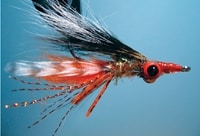
Beachbug-6
I developed Q’s Beach Bug while fishing the Southern California surf zone for barred surf perch, yellowfin croaker and corbina. This fly, inspired by an old friend, is an attractor pattern representing such beach-dwelling crustaceans as a molting sand crab or a baby ghost shrimp.
I was very fortunate to have Nick Curcione, a pioneer of the sport, introduce me to the game of fly-fishing in the surf. I met Nick in the late ’80s at a Loyola Marymount University Alumni barbecue. We instantly became friends and started tying flies together. Even though Nick has never claimed to be a very efficient fly tier, he showed me the ropes and helped me understand some of the most important qualities in a good surf pattern. He is always experimenting with new ideas and still remains eager to share. The Beach Bug is a tribute to him.
I like to attach this fly to a very short 3- to 4-foot leader with a nonslip mono loop so it can dive and move naturally along the bottom where most of the surf fish forage. A series of short strips with an occasional long one usually gets their attention.
This pattern has been very effective on the West Coast of the United States for large surf perch, as well as corbina and yellowfin croakers along with many other local species. The Beach Bug can be tied in a variety of sizes and colors, according to the specific conditions and fish you want to target. Because it resembles a shrimp or crab, it would readily work for striped bass in the surf in New England, and though I have never tried it, I bet that it would do very well in my standard colors for redfish and even trout. Tied in slightly lighter colors it should also work on bonefish and possibly even permit in the Caribbean. For these last two fish I would recommend you tie it with lighter beadchain eyes when fishing it in shallow water or for tailers.
I have had great success with this pattern over the years, and I hope it finds a place in your fly box or, better yet, in the lip of a fish.
MATERIAL
Hook: #4 or #6 – Any long shank streamer hook, Tiemco 200R or Mustad S74S-SS
Thread: Guidebrod 6/0 tan or red
Tail: Orange wool or marabou – Two small grizzley hackles on each side of fly – Finish with 4-6 strands of Copper Crystal Flash
Legs: Two Sili-legs on each side in orange/black or tan/black
Body: Rootbeer or olive small estaz
Wing: Squirrel Tail
Eyes: Painted red lead dumbell
Finish: Five minute epoxy or Tuffleye for head and wraps
Click on the second page to see step-by-step tying instruction.>
Tying Instructions
**
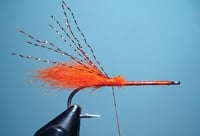
Step 1:** Cover the entire shank with thread and tie a small clump of orange wool at the approximate level of the point of the hook. Add a few strands of copper Crystal Flash.
**
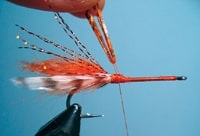
Step 2:** Tie in a small grizzly hackle on each side, and then coat the wraps with some head cement. Cut two pieces of Sili-legs approximately 2 inches in length. Fold them around your thread and tie them in on the top of the shank. Fold them back, wrap over them a few times to secure, then cement.
**
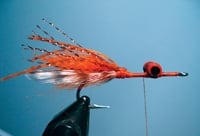
Step 3:** Tie in the lead eyes using a series of figure-eight wraps, then put a bead of Zap-a-Gap on them to keep them from turning on the shank.
**
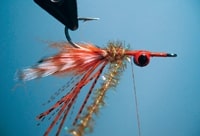
Step 4:** Turn the fly over. Wrap your thread back to the original tie-in point and tie in the Estaz. Wrap the Estaz around the shank to the back of the lead eyes, then bring the thread in front of the eyes.
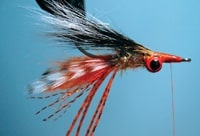
Step 5: Cut a sparse amount of squirrel tail to just short of the length of the fly and tie it in front of the eyes. Take a few additional wraps around the hair behind the eyes as well so that the squirrel lies down properly, and tie off.
**
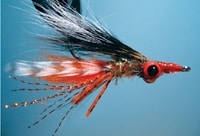
Step 6:** Trim the Sili-legs so they don’t wrap around the shank and foul. Finish the thread wraps with one coat of epoxy.
–Tying sequence by Al Quattrocchi









